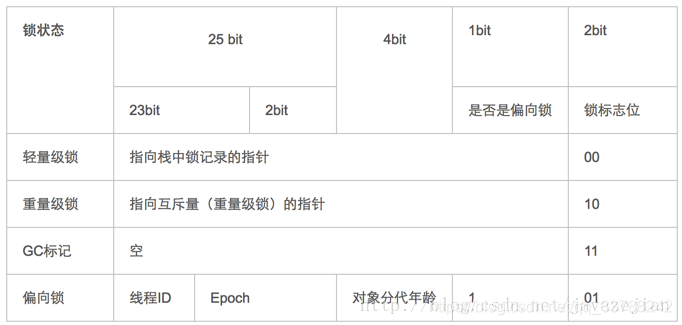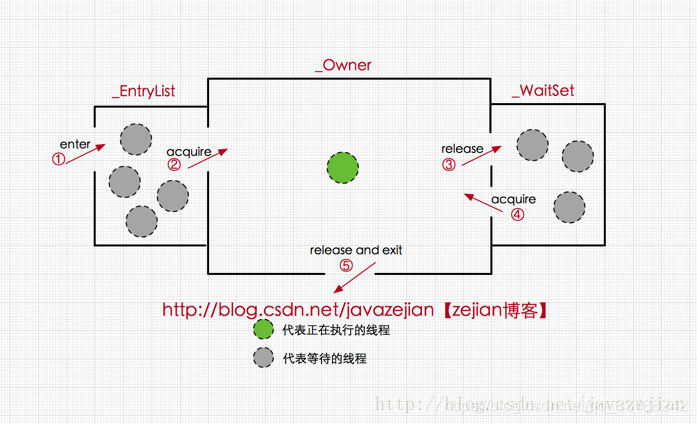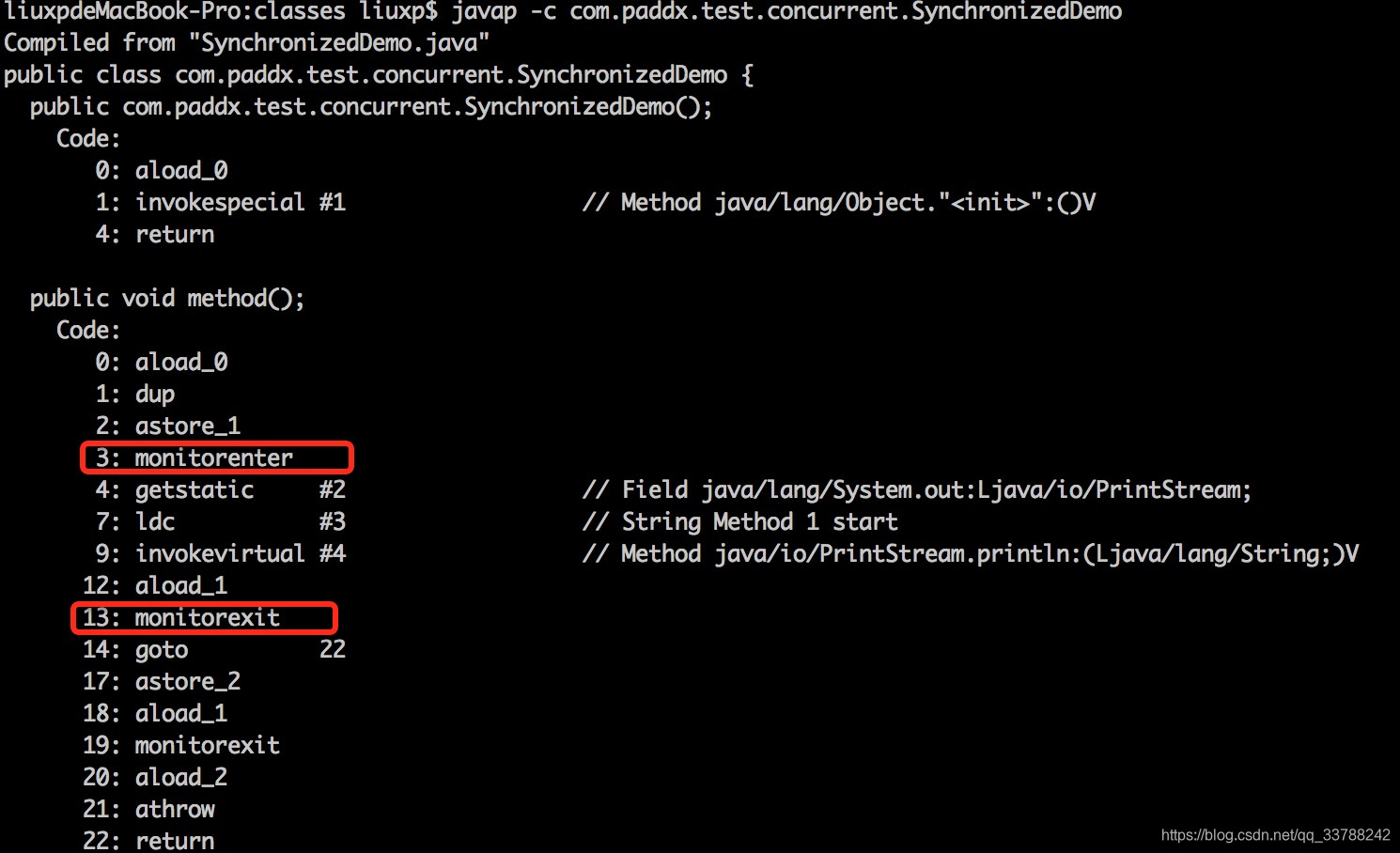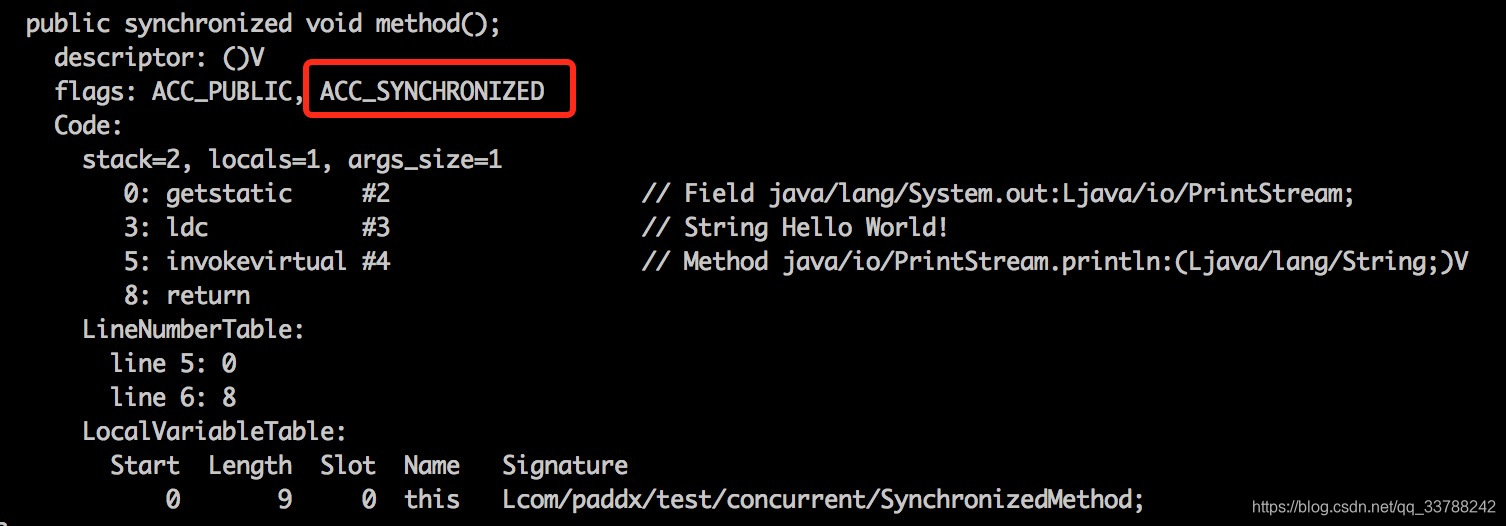一、Synchronized的基本使用
Synchronized是Java中解决并发问题的一种最常用的方法,也是最简单的一种方法,是并发集合类的基础。Synchronized的作用主要有三个:(1)确保线程互斥的访问同步代码(2)保证共享变量的修改能够及时可见(3)有效解决重排序问题。从语法上讲,Synchronized总共有三种用法:
(1)修饰普通方法
(2)修饰静态方法
(3)修饰代码块
接下来我就通过几个例子程序来说明一下这三种使用方式(为了便于比较,三段代码除了Synchronized的使用方式不同以外,其他基本保持一致)。
1、没有同步的情况:
代码段一:
package com.paddx.test.concurrent;
public class SynchronizedTest {
public void method1(){
System.out.println("Method 1 start");
try {
System.out.println("Method 1 execute");
Thread.sleep(3000);
} catch (InterruptedException e) {
e.printStackTrace();
}
System.out.println("Method 1 end");
}
public void method2(){
System.out.println("Method 2 start");
try {
System.out.println("Method 2 execute");
Thread.sleep(1000);
} catch (InterruptedException e) {
e.printStackTrace();
}
System.out.println("Method 2 end");
}
public static void main(String[] args) {
final SynchronizedTest test = new SynchronizedTest();
new Thread(new Runnable() {
@Override
public void run() {
test.method1();
}
}).start();
new Thread(new Runnable() {
@Override
public void run() {
test.method2();
}
}).start();
}
}
执行结果如下,线程1和线程2同时进入执行状态,线程2执行速度比线程1快,所以线程2先执行完成,这个过程中线程1和线程2是同时执行的。
Method 1 start
Method 1 execute
Method 2 start
Method 2 execute
Method 2 end
Method 1 end
2、对普通方法同步:
代码段二:
package com.paddx.test.concurrent;
public class SynchronizedTest {
public synchronized void method1(){
System.out.println("Method 1 start");
try {
System.out.println("Method 1 execute");
Thread.sleep(3000);
} catch (InterruptedException e) {
e.printStackTrace();
}
System.out.println("Method 1 end");
}
public synchronized void method2(){
System.out.println("Method 2 start");
try {
System.out.println("Method 2 execute");
Thread.sleep(1000);
} catch (InterruptedException e) {
e.printStackTrace();
}
System.out.println("Method 2 end");
}
public static void main(String[] args) {
final SynchronizedTest test = new SynchronizedTest();
new Thread(new Runnable() {
@Override
public void run() {
test.method1();
}
}).start();
new Thread(new Runnable() {
@Override
public void run() {
test.method2();
}
}).start();
}
}
执行结果如下,跟代码段一比较,可以很明显的看出,线程2需要等待线程1的method1执行完成才能开始执行method2方法。
Method 1 start
Method 1 execute
Method 1 end
Method 2 start
Method 2 execute
Method 2 end
3、静态方法(类)同步
代码段三:
package com.paddx.test.concurrent;
public class SynchronizedTest {
public static synchronized void method1(){
System.out.println("Method 1 start");
try {
System.out.println("Method 1 execute");
Thread.sleep(3000);
} catch (InterruptedException e) {
e.printStackTrace();
}
System.out.println("Method 1 end");
}
public static synchronized void method2(){
System.out.println("Method 2 start");
try {
System.out.println("Method 2 execute");
Thread.sleep(1000);
} catch (InterruptedException e) {
e.printStackTrace();
}
System.out.println("Method 2 end");
}
public static void main(String[] args) {
final SynchronizedTest test = new SynchronizedTest();
final SynchronizedTest test2 = new SynchronizedTest();
new Thread(new Runnable() {
@Override
public void run() {
test.method1();
}
}).start();
new Thread(new Runnable() {
@Override
public void run() {
test2.method2();
}
}).start();
}
}
执行结果如下,对静态方法的同步本质上是对类的同步(静态方法本质上是属于类的方法,而不是对象上的方法),所以即使test和test2属于不同的对象,但是它们都属于SynchronizedTest类的实例,所以也只能顺序的执行method1和method2,不能并发执行。
Method 1 start
Method 1 execute
Method 1 end
Method 2 start
Method 2 execute
Method 2 end
4、代码块同步
代码段四
package com.paddx.test.concurrent;
public class SynchronizedTest {
public void method1(){
System.out.println("Method 1 start");
try {
synchronized (this) {
System.out.println("Method 1 execute");
Thread.sleep(3000);
}
} catch (InterruptedException e) {
e.printStackTrace();
}
System.out.println("Method 1 end");
}
public void method2(){
System.out.println("Method 2 start");
try {
synchronized (this) {
System.out.println("Method 2 execute");
Thread.sleep(1000);
}
} catch (InterruptedException e) {
e.printStackTrace();
}
System.out.println("Method 2 end");
}
public static void main(String[] args) {
final SynchronizedTest test = new SynchronizedTest();
new Thread(new Runnable() {
@Override
public void run() {
test.method1();
}
}).start();
new Thread(new Runnable() {
@Override
public void run() {
test.method2();
}
}).start();
}
}
执行结果如下,虽然线程1和线程2都进入了对应的方法开始执行,但是线程2在进入同步块之前,需要等待线程1中同步块执行完成。
Method 1 start
Method 1 execute
Method 2 start
Method 1 end
Method 2 execute
Method 2 end
二、理解Java对象头与Monitor
在解释Synchronized原理之前,先了解下Java对象头与Monitor,它是实现Synchronized的基础
在JVM中,对象在内存中的布局分为三块区域:对象头、实例数据和对齐填充。如下:

实例变量:存放类的属性数据信息,包括父类的属性信息,如果是数组的实例部分还包括数组的长度,这部分内存按4字节对齐。
填充数据:由于虚拟机要求对象起始地址必须是8字节的整数倍。填充数据不是必须存在的,仅仅是为了字节对齐,这点了解即可。
而对于顶部,则是Java头对象,它实现synchronized的锁对象的基础,这点我们重点分析它,一般而言,synchronized使用的锁对象是存储在Java对象头里的,jvm中采用2个字来存储对象头(如果对象是数组则会分配3个字,多出来的1个字记录的是数组长度),其主要结构是由Mark Word 和 Class Metadata Address 组成,其结构说明如下表:
| 虚拟机位数 | 头对象结构 | 说明 |
|---|---|---|
| 32/64bit | Mark Word | 存储对象的hashCode、锁信息或分代年龄或GC标志等信息 |
| 32/64bit | Class Metadata Address | 类型指针指向对象的类元数据,JVM通过这个指针确定该对象是哪个类的实例。 |
其中Mark Word在默认情况下存储着对象的HashCode、分代年龄、锁标记位等以下是32位JVM的Mark Word默认存储结构
| 锁状态 | 25bit | 4bit | 1bit是否是偏向锁 | 2bit 锁标志位 |
|---|---|---|---|---|
| 无锁状态 | 对象HashCode | 对象分代年龄 | 0 | 01 |
由于对象头的信息是与对象自身定义的数据没有关系的额外存储成本,因此考虑到JVM的空间效率,Mark Word 被设计成为一个非固定的数据结构,以便存储更多有效的数据,它会根据对象本身的状态复用自己的存储空间,如32位JVM下,除了上述列出的Mark Word默认存储结构外,还有如下可能变化的结构:

其中轻量级锁和偏向锁是Java 6 对 synchronized 锁进行优化后新增加的,稍后我们会简要分析。这里我们主要分析一下重量级锁也就是通常说synchronized的对象锁,锁标识位为10,其中指针指向的是monitor对象(也称为管程或监视器锁)的起始地址。每个对象都存在着一个 monitor 与之关联,对象与其 monitor 之间的关系有存在多种实现方式,如monitor可以与对象一起创建销毁或当线程试图获取对象锁时自动生成,但当一个 monitor 被某个线程持有后,它便处于锁定状态。在Java虚拟机(HotSpot)中,monitor是由ObjectMonitor实现的,其主要数据结构如下(位于HotSpot虚拟机源码ObjectMonitor.hpp文件,C++实现的)
ObjectMonitor() {
_header = NULL;
_count = 0; //记录个数
_waiters = 0,
_recursions = 0;
_object = NULL;
_owner = NULL;
_WaitSet = NULL; //处于wait状态的线程,会被加入到_WaitSet
_WaitSetLock = 0 ;
_Responsible = NULL ;
_succ = NULL ;
_cxq = NULL ;
FreeNext = NULL ;
_EntryList = NULL ; //处于等待锁block状态的线程,会被加入到该列表
_SpinFreq = 0 ;
_SpinClock = 0 ;
OwnerIsThread = 0 ;
}
ObjectMonitor中有两个队列,_WaitSet 和 _EntryList,用来保存ObjectWaiter对象列表( 每个等待锁的线程都会被封装成ObjectWaiter对象),_owner指向持有ObjectMonitor对象的线程,当多个线程同时访问一段同步代码时,首先会进入 _EntryList 集合,当线程获取到对象的monitor 后进入 _Owner 区域并把monitor中的owner变量设置为当前线程同时monitor中的计数器count加1,若线程调用 wait() 方法,将释放当前持有的monitor,owner变量恢复为null,count自减1,同时该线程进入 WaitSe t集合中等待被唤醒。若当前线程执行完毕也将释放monitor(锁)并复位变量的值,以便其他线程进入获取monitor(锁)。如下图所示

由此看来,monitor对象存在于每个Java对象的对象头中(存储的指针的指向),synchronized锁便是通过这种方式获取锁的,也是为什么Java中任意对象可以作为锁的原因,同时也是notify/notifyAll/wait等方法存在于顶级对象Object中的原因(关于这点稍后还会进行分析),ok~,有了上述知识基础后,下面我们将进一步分析synchronized在字节码层面的具体语义实现。
三、Synchronized 原理
如果对上面的执行结果还有疑问,也先不用急,我们先来了解Synchronized的原理,再回头上面的问题就一目了然了。我们先通过反编译下面的代码来看看Synchronized是如何实现对代码块进行同步的:
package com.paddx.test.concurrent;
public class SynchronizedDemo {
public void method() {
synchronized (this) {
System.out.println("Method 1 start");
}
}
}
反编译结果:

关于这两条指令的作用,我们直接参考JVM规范中描述:
monitorenter :
Each object is associated with a monitor. A monitor is locked if and only if it has an owner. The thread that executes monitorenter attempts to gain ownership of the monitor associated with objectref, as follows:
• If the entry count of the monitor associated with objectref is zero, the thread enters the monitor and sets its entry count to one. The thread is then the owner of the monitor.
• If the thread already owns the monitor associated with objectref, it reenters the monitor, incrementing its entry count.
• If another thread already owns the monitor associated with objectref, the thread blocks until the monitor's entry count is zero, then tries again to gain ownership.
这段话的大概意思为:
每个对象有一个监视器锁(monitor)。当monitor被占用时就会处于锁定状态,线程执行monitorenter指令时尝试获取monitor的所有权,过程如下:
1、如果monitor的进入数为0,则该线程进入monitor,然后将进入数设置为1,该线程即为monitor的所有者。
2、如果线程已经占有该monitor,只是重新进入,则进入monitor的进入数加1.
3.如果其他线程已经占用了monitor,则该线程进入阻塞状态,直到monitor的进入数为0,再重新尝试获取monitor的所有权。
monitorexit:
The thread that executes monitorexit must be the owner of the monitor associated with the instance referenced by objectref.
The thread decrements the entry count of the monitor associated with objectref. If as a result the value of the entry count is zero, the thread exits the monitor and is no longer its owner. Other threads that are blocking to enter the monitor are allowed to attempt to do so.
这段话的大概意思为:
执行monitorexit的线程必须是objectref所对应的monitor的所有者。
指令执行时,monitor的进入数减1,如果减1后进入数为0,那线程退出monitor,不再是这个monitor的所有者。其他被这个monitor阻塞的线程可以尝试去获取这个 monitor 的所有权。
通过这两段描述,我们应该能很清楚的看出Synchronized的实现原理,Synchronized的语义底层是通过一个monitor的对象来完成,其实wait/notify等方法也依赖于monitor对象,这就是为什么只有在同步的块或者方法中才能调用wait/notify等方法,否则会抛出java.lang.IllegalMonitorStateException的异常的原因。
我们再来看一下同步方法的反编译结果:
源代码:
package com.paddx.test.concurrent;
public class SynchronizedMethod {
public synchronized void method() {
System.out.println("Hello World!");
}
}
反编译结果:

从反编译的结果来看,方法的同步并没有通过指令monitorenter和monitorexit来完成(理论上其实也可以通过这两条指令来实现),不过相对于普通方法,其常量池中多了ACC_SYNCHRONIZED标示符。JVM就是根据该标示符来实现方法的同步的:当方法调用时,调用指令将会检查方法的 ACC_SYNCHRONIZED 访问标志是否被设置,如果设置了,执行线程将先获取monitor,获取成功之后才能执行方法体,方法执行完后再释放monitor。在方法执行期间,其他任何线程都无法再获得同一个monitor对象。 其实本质上没有区别,只是方法的同步是一种隐式的方式来实现,无需通过字节码来完成。
四、运行结果解释
有了对Synchronized原理的认识,再来看上面的程序就可以迎刃而解了。
1、代码段2结果:
虽然method1和method2是不同的方法,但是这两个方法都进行了同步,并且是通过同一个对象去调用的,所以调用之前都需要先去竞争同一个对象上的锁(monitor),也就只能互斥的获取到锁,因此,method1和method2只能顺序的执行。
2、代码段3结果:
虽然test和test2属于不同对象,但是test和test2属于同一个类的不同实例,由于method1和method2都属于静态同步方法,所以调用的时候需要获取同一个类上monitor(每个类只对应一个class对象),所以也只能顺序的执行。
3、代码段4结果:
对于代码块的同步实质上需要获取Synchronized关键字后面括号中对象的monitor,由于这段代码中括号的内容都是this,而method1和method2又是通过同一的对象去调用的,所以进入同步块之前需要去竞争同一个对象上的锁,因此只能顺序执行同步块。
五、Java虚拟机对synchronized的优化
锁的状态总共有四种,无锁状态、偏向锁、轻量级锁和重量级锁。随着锁的竞争,锁可以从偏向锁升级到轻量级锁,再升级的重量级锁,但是锁的升级是单向的,也就是说只能从低到高升级,不会出现锁的降级,关于重量级锁,前面我们已详细分析过,下面我们将介绍偏向锁和轻量级锁以及JVM的其他优化手段,这里并不打算深入到每个锁的实现和转换过程更多地是阐述Java虚拟机所提供的每个锁的核心优化思想,毕竟涉及到具体过程比较繁琐,如需了解详细过程可以查阅《深入理解Java虚拟机原理》。
偏向锁
偏向锁是Java 6之后加入的新锁,它是一种针对加锁操作的优化手段,经过研究发现,在大多数情况下,锁不仅不存在多线程竞争,而且总是由同一线程多次获得,因此为了减少同一线程获取锁(会涉及到一些CAS操作,耗时)的代价而引入偏向锁。偏向锁的核心思想是,如果一个线程获得了锁,那么锁就进入偏向模式,此时Mark Word 的结构也变为偏向锁结构,当这个线程再次请求锁时,无需再做任何同步操作,即能获取锁的过程,这样就省去了大量有关锁申请的操作,从而也就提供程序的性能。所以,对于没有锁竞争的场合,偏向锁有很好的优化效果,毕竟极有可能连续多次是同一个线程申请相同的锁。但是对于锁竞争比较激烈的场合,偏向锁就失效了,因为这样场合极有可能每次申请锁的线程都是不相同的,因此这种场合下不应该使用偏向锁,否则会得不偿失,需要注意的是,偏向锁失败后,并不会立即膨胀为重量级锁,而是先升级为轻量级锁。下面我们接着了解轻量级锁。
轻量级锁
倘若偏向锁失败,虚拟机并不会立即升级为重量级锁,它还会尝试使用一种称为轻量级锁的优化手段(1.6之后加入的),此时Mark Word 的结构也变为轻量级锁的结构。轻量级锁能够提升程序性能的依据是“对绝大部分的锁,在整个同步周期内都不存在竞争”,注意这是经验数据。需要了解的是,轻量级锁所适应的场景是线程交替执行同步块的场合,如果存在同一时间访问同一锁的场合,就会导致轻量级锁膨胀为重量级锁。
自旋锁
轻量级锁失败后,虚拟机为了避免线程真实地在操作系统层面挂起,还会进行一项称为自旋锁的优化手段。这是基于在大多数情况下,线程持有锁的时间都不会太长,如果直接挂起操作系统层面的线程可能会得不偿失,毕竟操作系统实现线程之间的切换时需要从用户态转换到核心态,这个状态之间的转换需要相对比较长的时间,时间成本相对较高,因此自旋锁会假设在不久将来,当前的线程可以获得锁,因此虚拟机会让当前想要获取锁的线程做几个空循环(这也是称为自旋的原因),一般不会太久,可能是50个循环或100循环,在经过若干次循环后,如果得到锁,就顺利进入临界区。如果还不能获得锁,那就会将线程在操作系统层面挂起,这就是自旋锁的优化方式,这种方式确实也是可以提升效率的。最后没办法也就只能升级为重量级锁了。
锁消除
消除锁是虚拟机另外一种锁的优化,这种优化更彻底,Java虚拟机在JIT编译时(可以简单理解为当某段代码即将第一次被执行时进行编译,又称即时编译),通过对运行上下文的扫描,去除不可能存在共享资源竞争的锁,通过这种方式消除没有必要的锁,可以节省毫无意义的请求锁时间。
六、等待唤醒机制与synchronized
所谓等待唤醒机制本篇主要指的是notify/notifyAll和wait方法,在使用这3个方法时,必须处于synchronized代码块或者synchronized方法中,否则就会抛出IllegalMonitorStateException异常,这是因为调用这几个方法前必须拿到当前对象的监视器monitor对象,也就是说notify/notifyAll和wait方法依赖于monitor对象,在前面的分析中,我们知道monitor 存在于对象头的Mark Word 中(存储monitor引用指针),而synchronized关键字可以获取 monitor ,这也就是为什么notify/notifyAll和wait方法必须在synchronized代码块或者synchronized方法调用的原因。
synchronized (obj) {
obj.wait();
obj.notify();
obj.notifyAll();
}
需要特别理解的一点是,与sleep方法不同的是wait方法调用完成后,线程将被暂停,但wait方法将会释放当前持有的监视器锁(monitor),直到有线程调用notify/notifyAll方法后方能继续执行,而sleep方法只让线程休眠并不释放锁。同时notify/notifyAll方法调用后,并不会马上释放监视器锁,而是在相应的synchronized(){}/synchronized方法执行结束后才自动释放锁。








 本文围绕Java的Synchronized展开,介绍其基本用法,包括修饰普通方法、静态方法和代码块。阐述了Java对象头与Monitor,分析Synchronized原理,解释运行结果。还介绍了JVM对其的优化,如偏向锁、轻量级锁等,最后说明了等待唤醒机制与Synchronized的关系。
本文围绕Java的Synchronized展开,介绍其基本用法,包括修饰普通方法、静态方法和代码块。阐述了Java对象头与Monitor,分析Synchronized原理,解释运行结果。还介绍了JVM对其的优化,如偏向锁、轻量级锁等,最后说明了等待唤醒机制与Synchronized的关系。
















 438
438

 被折叠的 条评论
为什么被折叠?
被折叠的 条评论
为什么被折叠?








